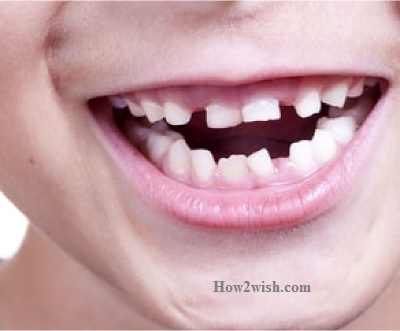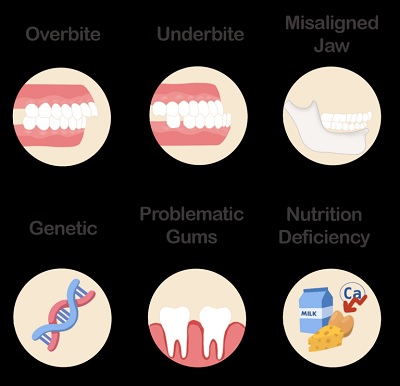What do you know about Crooked Milk Teeth? Every parent dreams of their child having a beautiful dazzling smile. Sometimes it happens that the dentitions are bent and deviate significantly from the generally established normative indicators. Crooked teeth in children require an immediate visit to the orthodontist and an appointment for quality treatment. Otherwise, serious consequences are possible that worsen the quality of life and the mental state of a person.

Causes of curvature
There are many provoking factors that can lead to the curvature of the formed series. If one or both parents have a similar problem, with a high degree of probability it will also affect the baby. In addition to unfavorable heredity, deformation changes often provoke a deficiency of nutrients in the diet of a pregnant or nursing mother, too soft food on the baby’s menu, chronic diseases accompanied by mouth breathing, bad habits, and congenital anomalies.
Allergies, asthma (bronchial spasms), bone formation disorder and lack of mineralization, dysplasia, and shortened frenulum are also common reasons why the first milk teeth grow crooked and uneven in a child.
Health and nutritional problems in the expectant mother
Many women mistakenly believe that they should think about the health and well-being of the baby only after he is born. It is important to remember that all the organs of a small person are formed during fetal development. Until the 12th gestational week, the rudiments of vital systems are laid, so any pathological factors can lead to abortion. However, this does not mean at all that immediately before childbirth, overeating and abuse of fatty, floury, and canned foods are welcome.
Proper nutrition for a woman in labor plays a crucial role in each trimester of pregnancy. You need to eat healthy foods rich in vitamins, minerals, and other essential components.
It is worth taking care of your health, and not visiting crowded places, especially during seasonal epidemics. In the presence of chronic diseases and other pathologies, it is recommended to carefully monitor the state of health and the results of laboratory and other studies, since the slightest deviations from the norm can lead to developmental abnormalities, and the child will have crooked teeth.
Wrong process of eating
Newborns are fed breast milk or an adapted formula from a bottle. In the first case, the probability of curvature is minimal, since in order to get food, the baby must make an effort. Such regular “training” contributes to the correct formation of the maxillofacial apparatus.
When the baby is bottle-fed, the risk of curvature of the dental units increases. Moms and dads buy bottles with regular nipples, which negatively affects the work and development of the jaw. The liquid pours too quickly from a wide opening, the baby does not need to strain once again to get the next serving of food.
Late introduction of solid foods
Sometimes parents, fearing harming the baby, try to introduce foods that need to be chewed into the diet as late as possible. This is one of the most common reasons why a child has crooked and uneven baby milk teeth. He constantly feeds on milk and pureed fruits, vegetables, meat, and fish purees, although he is physiologically ready to grind small pieces on his own. If you do not load the incisors and other units with chewing, they may not grow as they should.
Bad habits
Parents should carefully monitor the baby and stop all attempts to gnaw on foreign objects (with the exception of rodents specially designed for this), bite their lips, and suck their fingers. It is also important to minimize the use of a pacifier, especially if the little person is already a year old. All of these factors lead to deformation changes.

Mouth breathing
Babies breathe through their mouths when they have a cold and are unable to breathe through their noses. The same thing happens with ENT diseases, chronic rhinitis, and adenoiditis (inflammatory process in the adenoids). As a result, the baby’s tongue begins to press on the front of the jaw, which gradually curves.
The main causes of the appearance of pathology in permanent occlusion in children
Problems in which a child crookedly comes out and grows new molars are often observed with a curvature of the milk rows and untimely treatment. In addition, curvature appears under the influence of other factors:
- Premature removal of temporary dental units. Over time, neighboring crowns shift, trying to take the vacant place. It turns out that new ones have to change the direction of growth.
- Bruxism. With a similar pathology, children’s jaws involuntarily clench in a dream, during stressful situations, with emotional outbursts. All this leads to distortion.
- Late bite change. With untimely loss of replaceable incisors, canines, and premolars, permanent ones appear in places that are not intended for them. Rows can overlap and form crowding.
- Poor nutrition, the predominance of soft foods on the menu, and excessive consumption of confectionery and sweets.
When to Go to the Orthodontist
What to do when a baby’s milk tooth grows crooked? It is best to visit a specialist after the completion of the formation of temporary incisors, canines, premolars, and molars. This happens on average in 2-3 years. The doctor will examine the oral cavity, assess the condition of the maxillofacial apparatus, and develop a plan for further action for mom and dad.
Sometimes the problem is solved simply: it is enough to help the baby get rid of bad habits or perform special exercises. You may need to consult with an ENT or other specialized physician.
Tremas and diastemas (large gaps between crowns) in preschool and primary school age should not be a cause for concern. The child’s body is preparing for the imminent appearance of large molars, so the jaws expand.
Dangerous consequences of crooked teeth in children: what will happen if the anomaly is not treated
The curvature of the dentition without timely intervention can lead to serious problems. Firstly, a younger student or teenager will become embarrassed by an open smile and be afraid of peer ridicule, will withdraw himself, and will avoid social interaction. Secondly, bite deformation makes it difficult to access crowns and interdental spaces, as a result, the quality of hygiene procedures decreases, and bacteria actively multiply on the mucous membranes and enamel, which leads to caries and other diseases. There is an unpleasant smell from the mouth, and plaque and stones form on the surface, which can only be removed in a dental clinic.
If a child has a crooked tooth, he is not able to chew food well. The load on the maxillofacial apparatus is unevenly distributed, individual units experience the greatest pressure and undergo rapid destruction.
When the jaws are very tense, the same thing happens with the muscles, headaches can occur, and problems with the spine appear. Insufficiently chewed food enters the gastrointestinal tract and causes malfunctions in its work.
Curved crowns often provoke the occurrence of injuries to the mucous membranes. The child is faced with stomatitis – a disease that is characterized by pronounced unpleasant symptoms and a long course.
Treatment Methods
There are many options for resolving the issue. What to do depends on the causes of crooked teeth in children and the severity of the problem. First of all, it is recommended to consult a doctor dealing with malocclusion – an orthodontist. He will examine the oral cavity, prescribe the necessary examinations and decide on the method of intervention, taking into account the age of the patient.

Removable devices
Such systems are easily removed during meals, it is easy to carry out hygienic care with them. The only drawback is that mom and dad have to keep a close eye on the baby, who accidentally or on purpose can remove the corrective device.
Varieties:
- Orthodontic nipples. Suitable for babies only.
- Trainers. Flexible silicone structures are used in babies up to 7 years old. They fight functional pathologies, that is, they help to correct crooked teeth in a child, both when breathing through the mouth and when the tongue is incorrectly positioned. As a result of treatment, the patient will begin to speak much better. Speech therapists welcome this intervention option and sometimes insist on it in violation of diction.
- Records. Established from 7 years to the onset of adolescence. They are thin metal arc-shaped wires with a polymer base, which are often supplemented with screws and springs for greater efficiency.
All of the above methods help to expand the jaw, if necessary.
Braces
If a child’s crooked permanent teeth climb unevenly and grow after the complete disappearance of milk teeth (usually at the age of 12-14 years), the use of braces will be most effective. However, parents should understand that a massive accessory is not attractive enough, so a small patient will initially be embarrassed to wear it. In addition, not everyone wants to endure physical discomfort. The main task of relatives is to convince the teenager of the need for intervention.
Helpful hints:
- Color, ceramic, and sapphire devices are aesthetically attractive and will help create a unique image;
- It is better to install braces during the holidays because, in the adaptation period, children experience discomfort due to rubbing of the mucous membranes, pain, and speech disorders;
- After installation, you do not need to plan long trips, because every 1-1.5 months it is worth visiting the orthodontist to reconfigure the pressure force of the system on the crowns.
Orthognathic surgery
What to do when uneven milk teeth grow in a child, all of the above methods did not show a positive result, and the existing skeletal anomalies affect not only the appearance but also the quality of life. In this case, surgery is indicated. However, most doctors note that surgical manipulations are contraindicated if the jaws have not yet formed, which means that it is better not to carry out the procedure until the baby is older.
Related post Gingivitis in a child – what is it, causes, symptoms and treatment of babies
After the operation, a long recovery period (about a month) is required. Subsequently, treatment continues with the use of braces, plates, or trainers.
Aligners: pros and cons
Transparent caps, which are superimposed on the entire dentition, where there is a separate cell for each unit, have become a real breakthrough in modern orthodontics. The removable design does not bring discomfort, it is soft and aesthetically attractive. There are other advantages:
- Ease of maintenance and operation;
- Preservation of the color of the overlays;
- Safety for mucous membranes;
- No discomfort when wearing;
- The material does not cause allergies or other adverse reactions;
- The short duration of therapy;
- Potential for preventive use.
Despite many advantages, until recently, this method was contraindicated for persons under 14 years of age, because:
- It affects not only the crooked milk teeth that have come out of the child but also the maxillofacial apparatus as a whole;
- Designed for a permanent bite;
- Wearing aligners requires self-discipline, which is often lacking in preschool and primary school children.
Medicine does not stand still, and manufacturers are now offering children’s designs suitable for the smallest patients.
Cons of this type of cap:
- High price;
- Long production (up to one and a half months);
- Inability to correct serious anomalies;
- If one cell is damaged, the entire structure can be significantly damaged;
- More time is required for hygiene procedures.
Is alignment expensive?
When a child cuts and grows crookedly new milk teeth and a decision is made on therapy, you need to be ready to give a “round” amount. The final cost of corrective measures depends on the complexity of the diagnosis and the chosen treatment option. One of the most affordable designs is a removable plate. The price ranges from 5 to 7 thousand rubles. A non-removable accessory will cost twice as much.

Trainers are also available but will cost 8 thousand roubles. (this includes the product itself, consultation, selection, and regular monitoring of the patient). Braces are the most expensive. A full cycle with all related services can result in an amount of 80-100 thousand rubles. This is not only the installation and constant correction of the system, but also the initial examination, diagnosis, taking impressions, sanitation of the oral cavity, dismantling, and subsequent restoration procedures. For clarification of the cost, we recommend contacting the clinic personally, since the amount directly depends on the individual characteristics of the patient, the tolerance of drugs, the need for preliminary treatment, and other nuances.
Measures to help prevent the development of pathology
Having figured out why a child’s milk teeth and molars are crooked, you can prevent the appearance of a problem in the very early stages. To do this, you must adhere to the following preventive measures:
- Establishing breastfeeding;
- Compliance with the bottle feeding technique if the baby is fed with a mixture;
- Exclusion of pacifiers in children older than a year;
- Getting rid of bad habits;
- Introducing solid foods into the diet immediately after the appearance of the first dental units;
- Daily high-quality oral hygiene;
- Maintaining the balance of vitamins and minerals in the child’s body;
- Regular visits to the dentist (at least once every six months) for the timely detection of orthodontic problems and the appointment of effective treatment.
Summing up on Crooked Milk Teeth
The issue of malocclusion should be resolved in infancy (use of pacifiers) or primary school age, that is, as early as possible. Otherwise, serious consequences of the physical and mental plan are possible. Before developing a therapeutic tactic, professional doctors, first of all, establish why very crooked teeth grow in children (photos of uneven jaws and corrected options can be seen below). With sufficiently serious anomalies of the maxillofacial apparatus that worsen the quality of life of a small person, surgical intervention is indicated. In other situations, you can get by with less radical methods (plates, trainers, braces), the choice of which depends on the age of the patient, his personal preferences, and the financial capabilities of the parents.